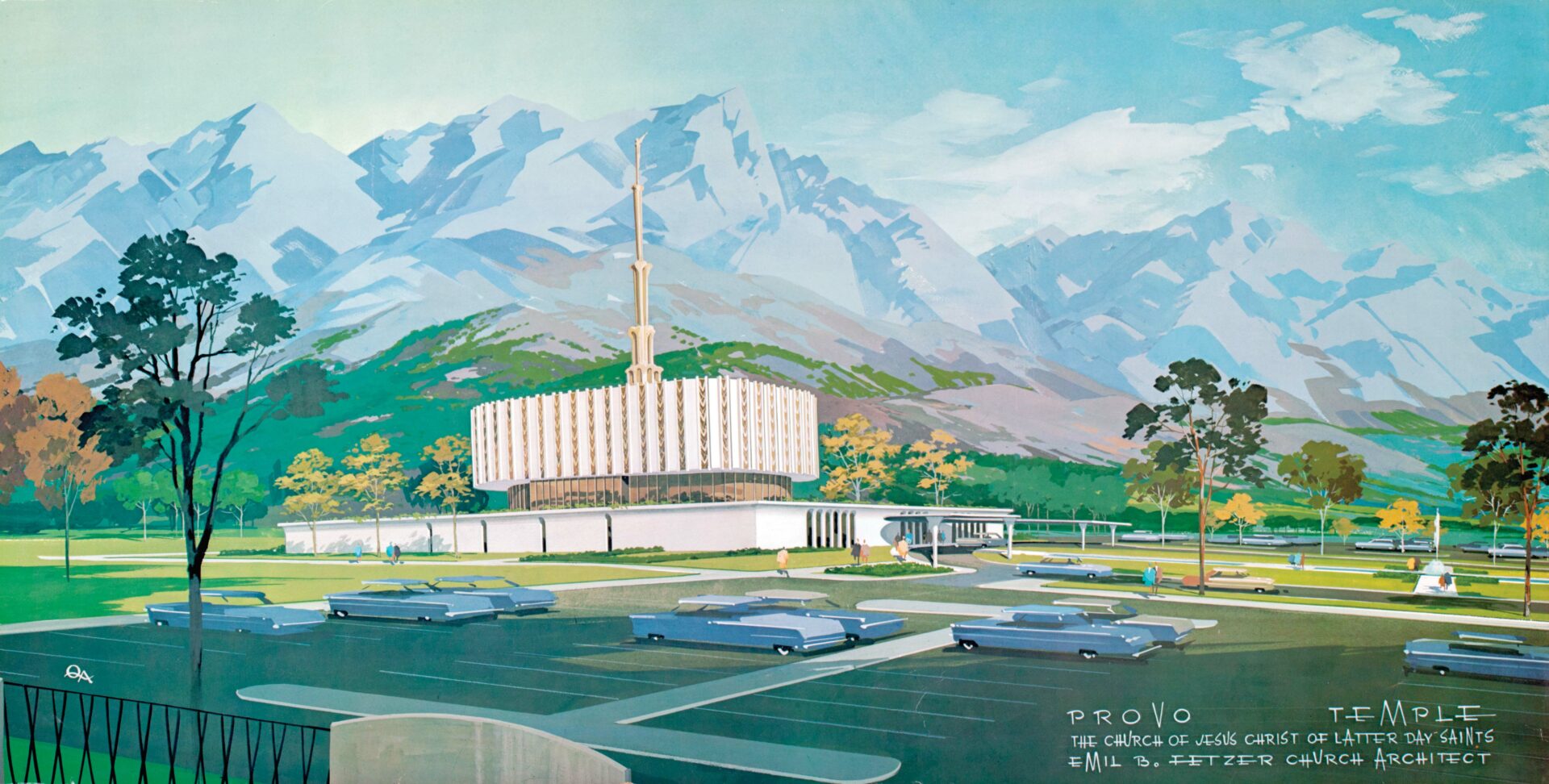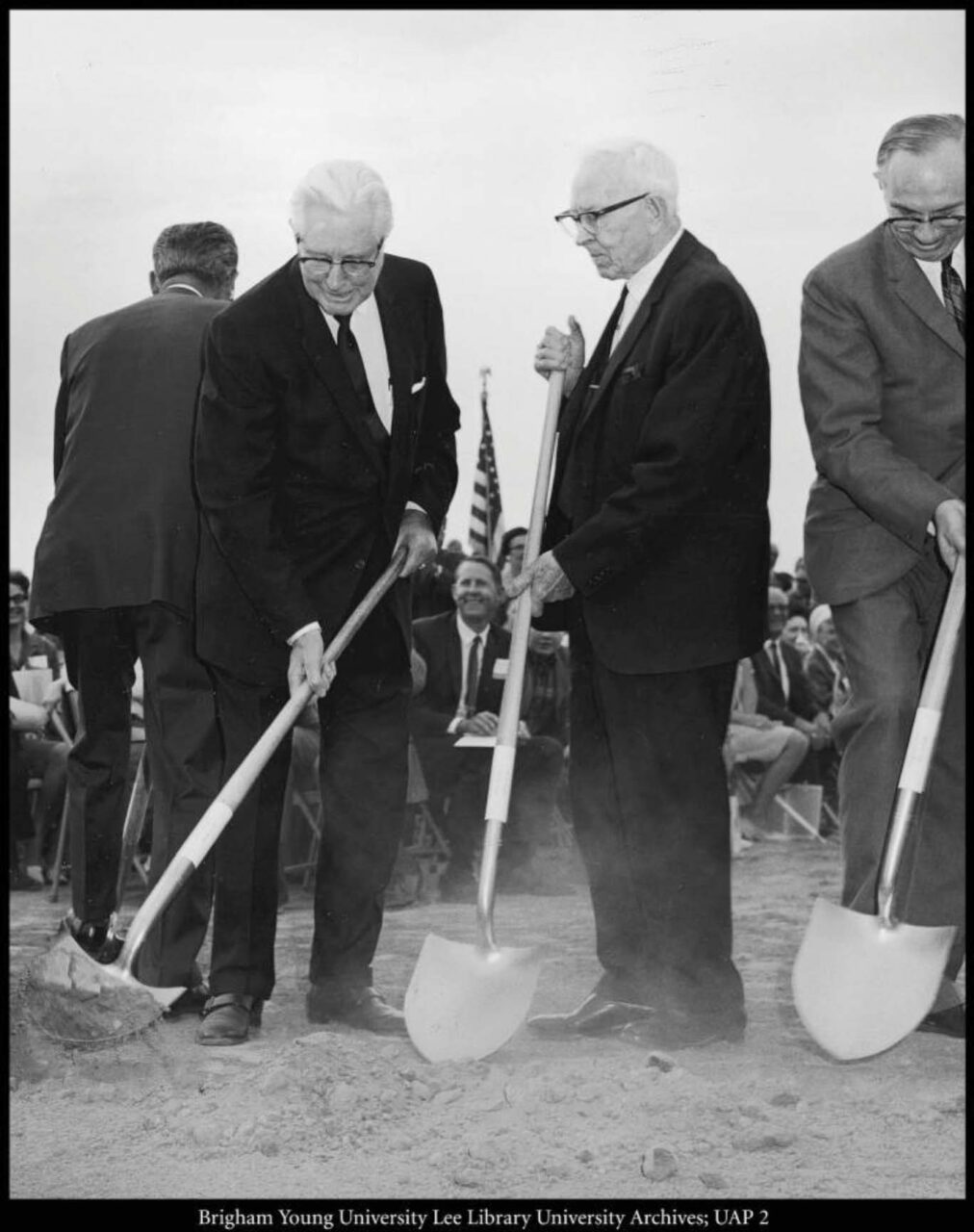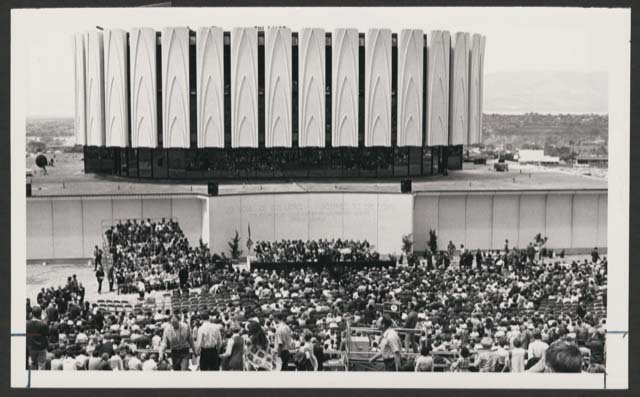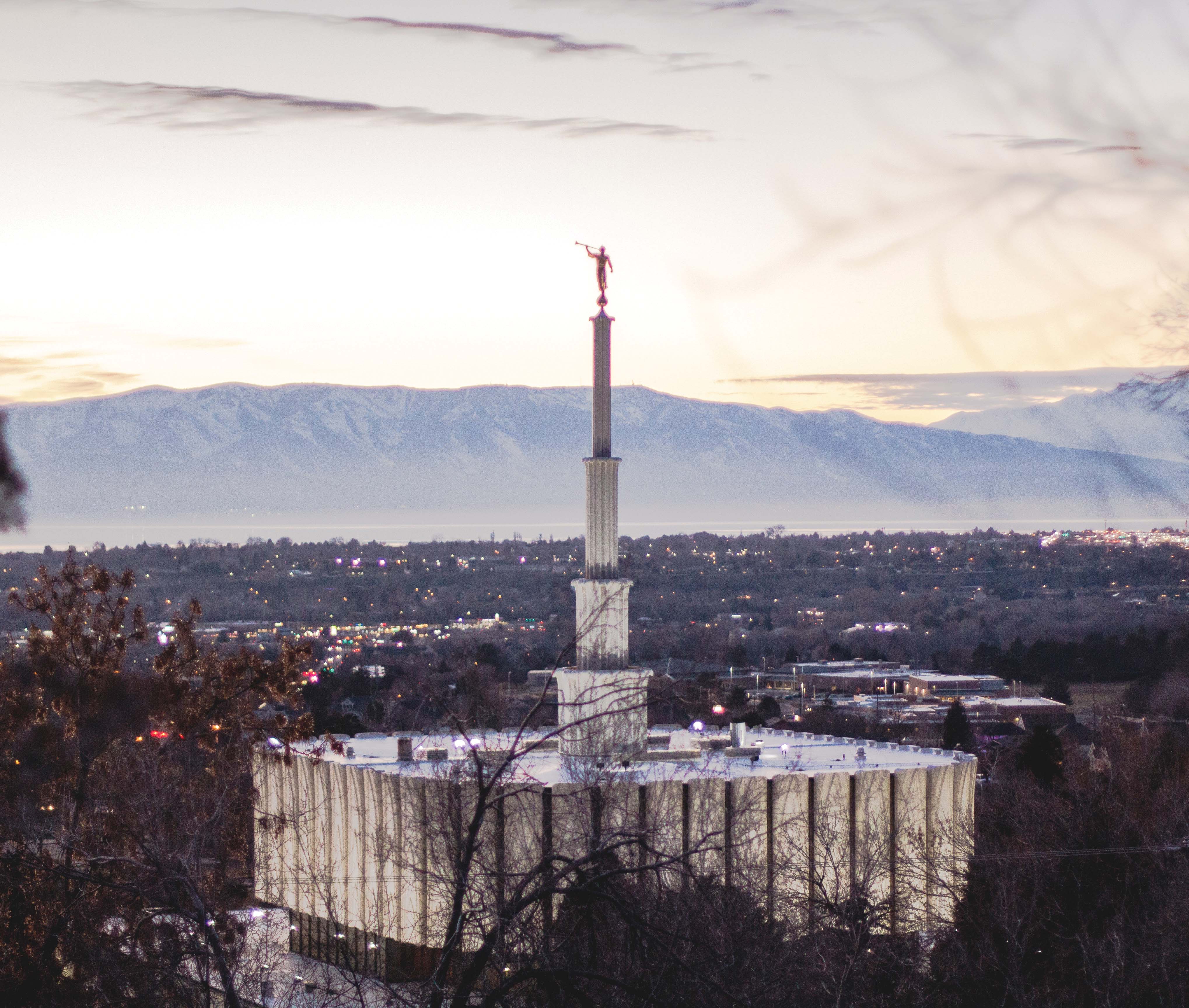
This rendering released by the First Presidency shows the initial design of the Provo Temple. President Russel M. Nelson announced plans to reconstruct the temple in the October 2021 General Conference, estimated to begin in fall 2023 after the completion of the Orem Temple. (L. Tom Perry Special Collections, Harold B. Lee Library)
Editor’s note: This story appeared in the February 2022 edition of The Daily Universe Magazine.
Richard Cowan sat in the newly built Provo Temple, listening to the angelic sound of a choir singing the “Hosanna Anthem.” When the signal came for the congregation to join in singing the hymn “The Spirit of God,” he looked around to see others, like him, too choked up to sing.
“It wasn’t until we got outside that any of us really felt like talking,” Cowan said of the dedicatory session. “It was just such an overwhelming, spiritual experience.”
The Provo Temple was dedicated in two sessions on Feb. 9, 1972. The dedicatory sessions were broadcast via closed-circuit TV to the Marriott Center and other campus buildings. In the dedicatory sessions, President Joseph Fielding Smith’s prayer was read by his first counselor, President Harold B. Lee. The end of the prayer eloquently explained the purpose of the Provo Temple:

“We humbly pray that thou wilt accept this edifice and pour out thy blessings upon it as a house to which thou wilt come and in which thy Spirit will direct all that is done, that it may be accepted unto thee. Let thy Spirit and blessings attend and guide all who officiate herein, that a feeling of holiness will prevail in every room of this, thy holy house. May all who enter have clean hands and pure hearts, and may they be built up in their faith and depart with a feeling of peace and praising thy holy name.”
Cowan is a co-author of the book “Provo’s Two Temples,” which traces the history of the Provo and Provo City Center temples. He attended the groundbreaking and dedication of the Provo Temple while serving as a stake president and working as a BYU religion professor.
The temple’s single spire, originally gold, rose out of the center of the round building. Cowan said many people believed the temple structure symbolized a pillar of fire rising out of a cloud. The spire was painted white after a statue of angel Moroni was placed on top in 2003.
As the temple reaches its 50-year anniversary, Cowan reflected on its importance to Provo residents, missionaries in the Missionary Training Center and BYU students. Cowan said the Provo Temple “set the pace” as the temple that performed more ordinances than any other, at least up until the Mount Timpanogos Temple opened in 1996. He called the Provo Temple a “spiritual heart of the community.”
President Russell M. Nelson announced plans to reconstruct the temple in the October 2021 General Conference. Cowan estimated that the reconstruction will begin in fall 2023, after the completion of the Orem Temple. “We want to have a local temple available where the missionaries and BYU students and others can go,” Cowan said.
Provo Temple worker Ann Calder is one of many community members impacted by the 50-year-old building. She said she loves working at the temple because of the wonderful people.
“There’s a wonderful spirit and there’s so much to learn,” she said.
Despite some Provo community members’ wishes to preserve the original temple structure, Calder said she trusts the plan for reconstruction.

First Presidency counselors President Hugh B. Brown and President Joseph Fielding Smith and Elder Gordon B. Hinckley of the Quorum of the Twelve turn the first shovelfuls at the Provo Temple groundbreaking. It may be President N. Eldon Tanner, second counselor in the First Presidency whose back is toward the camera. (L. Tom Perry Special Collections)
Timeline of the Provo Temple
Aug. 14, 1967 At a meeting with the 28 stake presidencies in the area, Presidents Hugh B. Brown and N. Eldon Tanner, counselors in the First Presidency, announced plans to build a temple in Provo. President Tanner told the attendees that in 1966 52% of all temple work was performed in the Salt Lake, Logan and Manti temples. At a similar meeting in Ogden the First Presidency announced plans to build a similar temple there.

Oct. 30, 1967 Church architect Emil B. Fetzer and Church Building Committee Vice-chairman Fred A. Baker discussed the flow of patrons and possible plans for the temples on an overnight flight to London. Fetzer described a temple with recommend desk, foyer and offices on the first floor, chapel and sealing rooms on the second and six ordinance rooms surrounding the celestial room on the third.
Jan. 24, 1968 Fetzer presented his plan for the Provo and Ogden temples to the First Presidency. Fetzer wrote in his memoirs he first explained the flow and function of the temple interior. Finally, he placed a rendering of the exterior on an easel. Fetzer wrote he heard a “very audible and distinct gasp.”
“I did not know what they expected to see,” he wrote, “but this was not it.” After a counselor in the First Presidency asked President McKay if he found the design offensive, President McKay responded, “No! I like it very much.” The design was approved.
August 1969 Ben E. Lewis, chairman of the fundraising committee reported in the Church News that members in the temple district stakes had contributed more than the assessed one million dollars for the temple’s construction.
Sept. 15, 1969 More than 12,000 people including 11 General Authorities gather for the groundbreaking ceremonies.
Jan. 8, 1970 President David O. McKay, ninth president of the Church passes away at 96.
May 21, 1971 With more than 6,000 spectators and 19 General Authorities watching, the new First Presidency (President Joseph Fielding Smith with counselors President Harold B. Lee and President N. Eldon Tanner) laid the cornerstone of the temple. Temple construction continued on the inside.
Jan. 10-29, 1972 The public was invited to an open house to view the completed temple. The Church News reported that more than 246,000 visitors attended the open house.

Feb. 9, 1972 The Provo Temple was dedicated in two sessions. Approximately 74,000 members attended in the temple and via closed-circuit television to nine buildings on the BYU campus including the Marriott Center, George Albert Smith Fieldhouse, Joseph Smith Building and Harris Fine Arts Center. President Joseph Fielding Smith prepared the dedicatory prayer and asked President Harold B. Lee to read the prayer for the 15th temple in the Church.
The prayer included the petition to “let that great temple of learning, the Brigham Young University, and all that is associated with it … be prospered to the full. Let thy enlightening power rest upon those who teach and those who are taught, that they may ‘seek learning, even by study and also by faith.’ … May those who teach and study in all academic fields have their souls enlightened with spiritual knowledge so they will turn to thy house for blessings and knowledge and learning that surpass all that may be found elsewhere.”
1997 The opening of the Mount Timpanogos Temple split the Provo Temple district. For the first time in 26 years, the Provo Temple was not the most productive in the Church.
October 1999 The Church standardized the naming of temples. The Provo Temple is now officially referred to as the Provo Utah Temple.
May 12, 2003 The statue of angel Moroni was added to Provo Utah Temple spire. The initial rendering showed a statue on the spire, but President McKay preferred no statue. The spire was built with the structure to support a statue. While the crane was in place, the gold spire was painted white.
Feb. 18, 2010 After announcing plans to renovate and reconfigure the Ogden Utah Temple, Temple Department Executive Director Elder William R. Walker of the First Quorum of the Seventy stated there was no plan for a similar renovation of the Provo Utah Temple (Ogden’s twin).

March 25, 2020 The First Presidency closed all temples because of the COVID-19 pandemic.
May 11, 2020 The Provo Utah Temple is one of 17 selected temples to reopen for living sealing ordinances. The temple added all living ordinances on Aug. 17, 2020, proxy baptisms on April 26, 2021 and all proxy ordinances June 14, 2021.
Oct. 3, 2021 At the conclusion of General Conference, President Russell M. Nelson announced plans to reconstruct the Provo Utah Temple after the Orem Utah Temple is dedicated and begins operation. No official date was given for the reconstruction to begin.
Nov. 24, 2021 The Church released a rendering of the reconstructed Provo Utah Temple. The design does not reference the modernist expression of Fetzer’s design, instead reflecting current temple architectural massing and styling similar to the Pocatello Idaho, Deseret Peak Utah, Taylorsville Utah, Saratoga Springs Utah, Orem Utah, Payson Utah and Red Cliffs Utah temples. Square footage and interior details have not been released.




